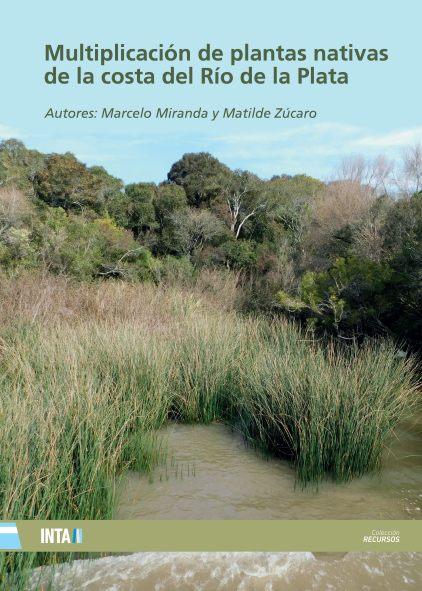Ver ítem
- xmlui.general.dspace_homeDirección Nacional y DNAsEEA Área Metropolitana de Buenos AiresInformes técnicosxmlui.ArtifactBrowser.ItemViewer.trail
Multiplicación de plantas nativas de la costa del Río de la Plata
Resumen
Native Plants grow forming more or less homogeneous plant communities and constitute – as primary Producers – a fundamental part of the ecosystems originating from a certain place. We find these communities in those environments with little or no human intervention, protected areas and where the characteristics of the natural environment (soils and ecosystem pulses) are conserved. They are recognized by their general appearance or physiognomy and by their
[ver mas...]
Native Plants grow forming more or less homogeneous plant communities and constitute – as primary Producers – a fundamental part of the ecosystems originating from a certain place. We find these communities in those environments with little or no human intervention, protected areas and where the characteristics of the natural environment (soils and ecosystem pulses) are conserved. They are recognized by their general appearance or physiognomy and by their species composition; They are popularly identified as: Pajonales, Matorrales, Talales, Montes, etc. Not all plants that grow spontaneously or wild are native to that place, some have arrived from other regions of the planet, which are “wild” and can even displace the site's own or original vegetation. The interest in its cultivation is largely due to the active process of biodiversity loss that exists in most of the environments of the Buenos Aires Metropolitan Area (AMBA). The “native” ones are part of the natural heritage that we must preserve and share with future generations. With their cultivation, the link between the population and the environment is strengthened, and the ancestral knowledge of the native peoples is revalued, who named them and used them for different uses: food, medicine, architecture, clothing, etc., and preserved them to this day. days. They fulfill relevant functions in the control of environmental pulses, providing populations with important ecosystem services, such as the control of excess water or the recharge of aquifers. They currently represent a gardening and landscaping sector with growing demand. They contribute to the agro-biodiversity of productive plots and form bio-corridors that counteract the excessive fragmentation of “natural” environments. This guide attempts to guide those growers who are starting out and are interested in forming a native plant nursery on a family scale, a productive enterprise or for environmental training1. It is largely nourished by the knowledge shared by many growers.
[Cerrar]
Las Plantas Nativas crecen formando comunidades vegetales más o menos homogéneas y constituyen –como Productores primarios– parte fundamental de los ecosistemas originarios de un determinado lugar. Dichas comunidades las hallamos en aquellos ambientes con poca o nula intervención humana, áreas protegidas y allí donde se conserven las características del medio natural (suelos y pulsos ecosistémicos). Se reconocen por su aspecto general o fisonomía y por su
[ver mas...]
Las Plantas Nativas crecen formando comunidades vegetales más o menos homogéneas y constituyen –como Productores primarios– parte fundamental de los ecosistemas originarios de un determinado lugar. Dichas comunidades las hallamos en aquellos ambientes con poca o nula intervención humana, áreas protegidas y allí donde se conserven las características del medio natural (suelos y pulsos ecosistémicos). Se reconocen por su aspecto general o fisonomía y por su composición de especies; popularmente se las identifica como: Pajonales, Matorrales, Talares, Montes, etc. No todas las plantas que crecen en forma espontánea o silvestre son nativas de ese lugar, algunas han llegado de otras regiones del planeta, las cuales se encuentran “asilvestradas” y pueden, incluso, desplazar a la vegetación propia u original del sitio. El interés por su cultivo se debe en gran medida al proceso activo de pérdida de biodiversidad que existe en la mayor parte de los ambientes del Área Metropolitana de Buenos Aires (AMBA). Las “nativas” forman parte del patrimonio natural que debemos preservar y compartir con las generaciones futuras. Con su cultivo se fortalece el vínculo entre la población y el ambiente, y se revaloriza el saber ancestral de los pueblos originarios, quienes las nombraron y las emplearon para distintos usos: alimentación, medicina, arquitectura, vestimenta, etc, y las preservaron hasta nuestros días. Cumplen funciones relevantes en el control de los pulsos ambientales brindando a las poblaciones servicios ecosistémicos importantes como por ejemplo el control de los excesos hídricos o la recarga de acuíferos. Actualmente representan un sector de la jardinería y paisajismo con una demanda creciente. Contribuyen a la agro-biodiversidad de las parcelas productivas y forman bio-corredores que contrarrestan la excesiva fragmentación de los ambientes “naturales”. La presente guía intenta orientar a aquellos cultivadores que se inicien y tengan interés en formar un vivero de plantas nativas a escala familiar, un emprendimiento productivo o para la formación ambiental1. En gran parte se nutre del saber compartido por muchos cultivadores.
[Cerrar]

Autor
Miranda, Marcelo Ademar;
Zúcaro, Matilde;
Fecha
2023
Editorial
Estación Experimental Agropecuaria Área Metropolitana de Buenos Aires, INTA
Documentos Relacionados
Formato
pdf
Tipo de documento
informe técnico
Proyectos
(ver más)
INTA/2023-PE-L03-I021, Consolidación de procesos locales para la co-gestión de los espacios urbanos y periurbanos del AMBA con énfasis en la problemática ambiental y la producción sostenible
Palabras Claves
Derechos de acceso
Abierto
 Excepto donde se diga explicitamente, este item se publica bajo la siguiente descripción: Creative Commons Attribution-NonCommercial-ShareAlike 2.5 Unported (CC BY-NC-SA 2.5)
Excepto donde se diga explicitamente, este item se publica bajo la siguiente descripción: Creative Commons Attribution-NonCommercial-ShareAlike 2.5 Unported (CC BY-NC-SA 2.5)


